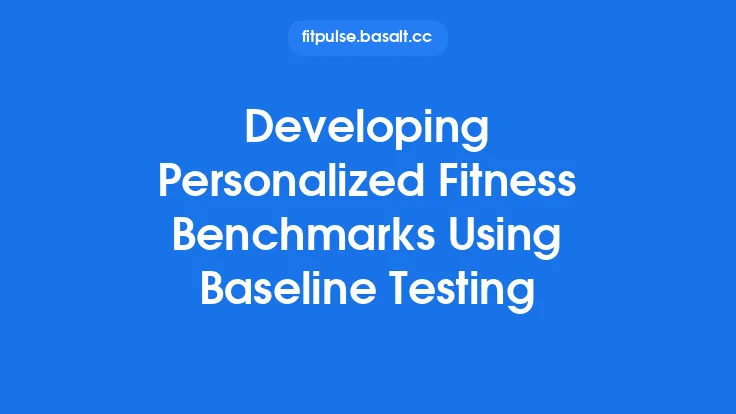Establishing a solid fitness baseline is the cornerstone of any effective training program. It provides a clear picture of where an individual stands physically, highlights strengths and potential limitations, and creates a data‑driven roadmap for future progress. By systematically gathering objective measurements and contextual information at the outset, trainers and clients can set realistic expectations, tailor interventions, and monitor change with confidence. This article walks through every step of a comprehensive baseline assessment, from preparation and data collection to interpretation and program integration, ensuring that the process is thorough, safe, and repeatable.
Why a Baseline Assessment Is Essential
- Objective Starting Point – Quantifiable data removes guesswork, allowing both trainer and client to see the exact status of key fitness domains.
- Goal Alignment – Baseline numbers make it possible to set SMART (Specific, Measurable, Achievable, Relevant, Time‑bound) goals that are rooted in reality.
- Risk Management – Identifying health concerns, movement restrictions, or asymmetries early helps prevent injury when the program begins.
- Motivation & Accountability – Seeing baseline numbers and later improvements provides tangible proof of progress, boosting adherence.
- Program Customization – Different fitness components (e.g., aerobic capacity vs. muscular endurance) can be weighted according to the client’s needs, based on the initial data.
Preparing for the Assessment
- Define the Scope – Decide which fitness domains are most relevant to the client’s goals (e.g., weight loss, sport‑specific performance, general health).
- Gather Equipment – Ensure calibrated tools are on hand: stadiometer, scale, skinfold calipers or bioelectrical impedance device, heart‑rate monitor, dynamometer, tape measure, goniometer, and a stopwatch.
- Create a Standardized Protocol – Write a step‑by‑step script covering warm‑up, measurement order, rest intervals, and safety checks. Consistency is key for future comparisons.
- Set the Environment – Choose a quiet, temperature‑controlled space with adequate lighting and privacy for body composition testing.
- Obtain Informed Consent – Explain the purpose, procedures, and any potential discomfort. Have the client sign a consent form that also outlines data confidentiality.
Collecting Health and Lifestyle Information
A comprehensive baseline begins with a questionnaire that captures the client’s medical history, current medications, previous injuries, and lifestyle habits. Important sections include:
- Medical Screening – Use a validated tool such as the PAR‑Q (Physical Activity Readiness Questionnaire) to flag contraindications.
- Injury History – Note any past musculoskeletal issues, surgeries, or chronic pain that could affect testing or training.
- Physical Activity Background – Document typical weekly activity volume, preferred modalities, and perceived exertion levels.
- Nutrition & Sleep – Briefly assess dietary patterns and sleep quality, as these influence performance and recovery.
- Stress & Mental Well‑Being – High stress can impact heart‑rate response and perceived effort; a simple Likert scale can be informative.
Anthropometric Measurements
These basic metrics provide a snapshot of size and proportion:
| Measurement | Method | Tips |
|---|---|---|
| Height | Stadiometer, barefoot, standing straight | Record to the nearest 0.1 cm |
| Body Mass | Calibrated digital scale, minimal clothing | Zero the scale before each client |
| Circumferences | Flexible tape, measured at standardized landmarks (e.g., waist at the narrowest point, hips at the widest) | Take each measurement twice; use the average |
| Segment Lengths (optional) | Measuring tape or anthropometer for limb lengths | Useful for biomechanical calculations in advanced programs |
Body Composition Analysis
Understanding the proportion of fat mass versus lean mass refines program focus:
- Skinfold Calipers – Measure at 3–7 sites (e.g., triceps, suprailiac, thigh) and apply a validated equation (e.g., Jackson‑Pollock).
- Bioelectrical Impedance Analysis (BIA) – Quick, non‑invasive; ensure the client is hydrated and has avoided food/drink for at least 2 hours.
- Dual‑Energy X‑Ray Absorptiometry (DXA) – Gold standard, but typically reserved for clinical or research settings due to cost and radiation exposure.
Record body fat percentage, fat‑free mass, and, if possible, segmental lean mass distribution.
Cardiovascular Capacity Evaluation
A baseline measure of aerobic fitness helps set training intensity zones:
- Resting Heart Rate (RHR) – Measured after 5 minutes of seated rest, using a heart‑rate monitor or manual pulse.
- Submaximal Test – Options include the 3‑Minute Step Test, Rockport Walk Test, or a treadmill/ergometer protocol that stops before volitional fatigue.
- VO₂max Estimation – Use the results from the submaximal test in established equations (e.g., ACSM’s treadmill prediction) to estimate maximal oxygen uptake.
Document the estimated VO₂max (ml·kg⁻¹·min⁻¹) and the corresponding heart‑rate zones (e.g., 50‑60 % HRR for endurance, 70‑85 % HRR for interval work).
Muscular Strength and Power Screening
These tests provide a quick yet reliable picture of the client’s ability to generate force:
- Handgrip Dynamometry – Measures maximal isometric grip strength; useful for overall muscular health and as a predictor of functional capacity.
- 1‑RM or 5‑RM Estimations – For major lifts (e.g., squat, bench press, deadlift), use a submaximal load and apply a repetition‑maximum prediction formula (e.g., Epley).
- Vertical Jump Test – Assesses lower‑body power; record jump height using a wall-mounted measuring tape or a jump mat.
- Medicine‑Ball Throw – Evaluates upper‑body power; measure distance of a seated or standing overhead throw.
When maximal testing is contraindicated, opt for submaximal protocols and calculate relative strength indices (e.g., load lifted per kilogram body mass).
Flexibility and Mobility Overview
Baseline flexibility informs warm‑up design and highlights potential movement restrictions:
- Sit‑and‑Reach Test – Standardized assessment of hamstring and lumbar flexibility.
- Shoulder Flexion/Extension – Measured with a goniometer; record the range of motion in degrees.
- Hip Flexor Length – Use the Thomas test or a modified lunge stretch to gauge hip extension capacity.
Document each measurement and note any asymmetries greater than 5‑10 degrees, which may warrant targeted mobility work.
Functional Movement Screening (Brief)
While a full movement‑quality analysis belongs to a separate article, a concise functional screen can still be part of the baseline:
- Squat to Chair – Observe depth, balance, and trunk stability.
- Single‑Leg Stance – Assess balance for 30 seconds each leg, eyes open.
- Push‑up Test – Count the maximum number of repetitions performed with proper form.
These simple checks provide a quick functional snapshot without delving into detailed technique analysis.
Establishing Normative Benchmarks
After collecting raw data, compare the client’s results to age‑ and sex‑specific normative tables (e.g., ACSM fitness norms, NHANES body composition data). This step helps:
- Identify areas that are above, at, or below average.
- Prioritize which fitness components need the most attention.
- Set realistic performance targets based on population standards.
Documenting and Interpreting Results
Create a structured report that includes:
- Client Profile – Age, sex, occupation, goals.
- Health Screening Summary – Any red flags, medical clearance notes.
- Raw Data Table – All measurements with units and testing conditions.
- Normative Comparison – Percentile or classification (e.g., “Below average cardiovascular fitness”).
- Strengths & Limitations – Bullet points highlighting key findings.
- Initial Recommendations – Broad programming suggestions (e.g., “Focus on aerobic conditioning 3 × week, incorporate full‑body strength sessions 2 × week”).
Store the report digitally with a timestamp, and back it up securely to ensure future accessibility.
Translating Baseline Data into Program Design
- Goal‑Specific Prioritization – If the client’s primary aim is weight loss, emphasize caloric expenditure and high‑volume cardio while still addressing identified strength deficits.
- Periodization Framework – Use baseline strength ratios to set appropriate loading percentages for each training block (e.g., 60‑70 % 1‑RM for endurance phases, 80‑85 % for strength phases).
- Exercise Selection – Choose movements that address identified mobility restrictions (e.g., hip flexor stretches before lower‑body squats).
- Progression Metrics – Define measurable milestones (e.g., increase VO₂max by 5 ml·kg⁻¹·min⁻¹, add 5 kg to squat 5‑RM) that will be revisited at scheduled reassessments.
By anchoring the program to concrete baseline numbers, the training plan becomes a logical extension of the client’s current status rather than a generic template.
Ensuring Safety and Ethical Considerations
- Medical Clearance – If any screening question raises concern, obtain physician approval before proceeding with strenuous testing.
- Informed Consent – Reiterate that participation is voluntary and that the client may stop any test at any time.
- Confidentiality – Store data in compliance with privacy regulations (e.g., GDPR, HIPAA) and limit access to authorized personnel only.
- Cultural Sensitivity – Be aware of modesty preferences during body measurements and provide appropriate privacy options.
Maintaining Records for Future Comparison
A baseline assessment is only valuable if it can be compared over time:
- Digital Database – Use a cloud‑based client management system that timestamps each entry and allows trend visualization.
- Version Control – Label each assessment (e.g., “Baseline – 2025‑10‑26”) and keep a log of any protocol modifications.
- Scheduled Re‑Testing – Plan follow‑up assessments at logical intervals (e.g., every 8–12 weeks) to capture meaningful change while minimizing testing fatigue.
Consistent record‑keeping not only tracks progress but also provides evidence of program efficacy for both the trainer and the client.
Final Thoughts
A comprehensive fitness baseline assessment is more than a checklist; it is a strategic, data‑driven foundation that informs every subsequent decision in the training journey. By meticulously preparing, gathering a balanced set of objective measurements, interpreting those numbers against normative standards, and translating the findings into a personalized program, trainers empower clients to pursue their goals with clarity, safety, and confidence. When the baseline is revisited periodically, the resulting trend data becomes a powerful narrative of improvement, reinforcing motivation and guiding continual refinement of the training plan.





